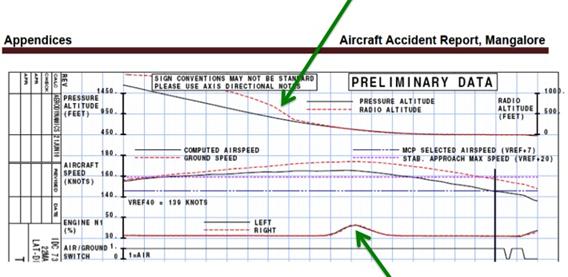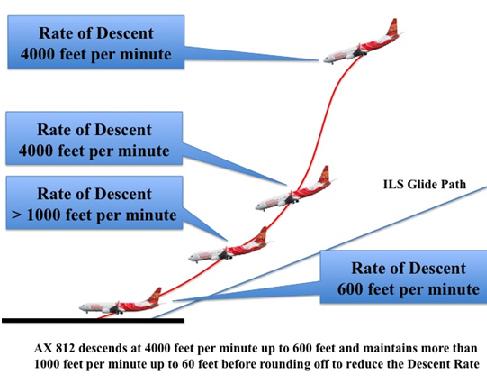The “ Hard Landing” circular issued by Air India is a major contributor to the accident and the COI report has chosen to ignore this vital fact.
By Capt. A. Ranganathan
The Court of Inquiry report on the crash of Air India Express flight 812 on 22nd May 2010 has concluded that only the pilot was responsible. On page 115/175 of the report, the direct causes are given as follows:
“The court of Inquiry determines that the cause of the accident was Captain’s failure to discontinue an “Unstabilised approach” and his persistence to continue with the landing, despite three calls from the First Officer to “go-around” and a number of warnings from the EGPWS”
The report is completely silent on the contributory factors when it comes to the failure of the Airline, the Airport Authority of India and the Regulator. The cover up of a circular on hard landing, issued by the Flight Safety Head of Air India, has been swept aside. On page 90/175 of the report, the following statement clearly indicates the cover-up.
2.2.18 Aspects of Hard Landing and Going Around
Flight Safety counseling on one-off incident of Hard Landing by Captain for 1.9 Vg which was much less than AMM limit of 2.1 Vg cannot be considered as a contributing factor towards the accident. Having been consistently unstabilised on the ILS Approach, even if the Captain had been able to stop the aircraft on the runway, the subsequent FOQA analysis of DFDR and possibily of CVR, would have indicated various violations of SOP by the Captain. This would have, in any case, warranted another reprimand by the authorities. In a high energy and fast approach, resulting in a very late touchdown, no prudent pilot would also aim to make a smooth touchdown to avoid flight safety counseling. The aircraft in this instant had not been able to remain firmly on ground because of higher speed at touchdown and not possibly because of any attempted smooth landing.
The last statement clearly indicates the effort to cover up the fact that the circular is one of the major factors that contributed to the accident. The Captain was definitely at fault in continuing the approach to land , in spite of being extremely high on profile as well as speed. However, the aircraft could have been stopped within the paved surface of the runway, if correct stopping techniques were employed. This was clearly stated by the report of the manufacturer, Boeing, on Page 159/175:
“ since the airplane’s final touchdown point was 5200 feet from Runway 24 threshold, the airplane could have come to a complete stop at 7600 feet from the threshold ( 438 feet of runway remaining )
The following image from the report is a clear indication that the COI has deliberately ignored an important factor:
The kink marked by the bottom arrow clearly indicates that the engine thrust was increased to cushion the landing. The normal landing should have been done with idle thrust but the Flight data recorded clearly indicates that there was more than idle thrust at touchdown. The top arrow indicates the vertical profile of the aircraft.
The Boeing report has also indicated that the aircraft had descent rate of more than 1000 feet per minute up to 60 feet above runway and then it has flattened out to a normal rate. The CVR ( Cockpit Voice Recorder ) readout is another clear indicator for this:
06:04:26
EGPWS Sink Rate Sink Rate
06:04:29
EGPWS Forty
06:04:30
EGPWS Thirty
06:04:31
EGPWS Twenty
06:04:32
EGPWS Ten
06:04:40
CAM [ Sound of 3 clicks and a squeal.-
( speed Brake handle? / MG TD?)
The COI has taken the sounds at 06;04;40 at the Main Gear touchdown, yet in several portions of the report , they indicate the touchdown as 06:04:41. Apart from this error, their contention that the circular on hard landing issued by air India has no bearing on the accident is faulty.
In Page 140/175, the COI report mentions the following
Timings and Correlation
Timing on the transcript was established by correlating CVR, DFDR and ATC recording. The time indicated in CVR transcript is in Indian Standard Time ( IST ) which is UTC + 5:30 hours
Taking the figures indicated in the COI report from the DFDR readouts, the above image is a graphical representation of what was the final profile of the aircraft. The flight was well above the ILS Glide path that it should have taken. The descent rate up to one mile from the runway threshold is more than 4000 feet per minute and the captain reduces the descent rate to more than 1000 feet per minute up to 60 feet above the runway surface. The COI report mentions that the captain violated the Standard Operating Procedure which requires a descent rate not exceeding 1000 feet per minute. However, they chose to ignore the CVR and DFDR indication which clearly points to the fact that the captain ignores all EGPWS warnings and the copilots call for Go-around, yet continues to land late by flattening out the approach. This is a classic case of what is called “Press-on-It is” in aviation safety parlance.
The COI report also ignores the fact mentioned in Page 79/175:
“As per recordings on the DFDR at 06:04:42 hours IST just before touchdown, Thrust levers were at 26 degrees and corresponding N2 at Left Engine was 76.8% and N2 on Right Engine was 78.1%.”
Apart from indicating that the COI report has not correlated the timings of CVR and DFDR ( the touch down is shown as 06:04:40 in the CVR while DFDR shows touchdown as 06:04:41 and on page 79 they indicate “just before touchdown as 06:04:42), the thrust lever indication of 26 degrees should have indicated to them that it was above “Idle” thrust which is the standard procedure for touchdown. The fact that the captain was using power for the touchdown indicated he is going for a smooth touchdown in spite of the fact that he was touching down very late. The following graphic is a representation of the last forty feet of the aircraft profile ( based on CVR recordings):
The action of the captain in arresting the high descent rate and making a smooth touchdown with power , is a clear indication that the counseling he had for the earlier hard landing was the influential factor. The “ Hard Landing” circular issued by Air India is a major contributor to the accident and the COI report has chosen to ignore this vital fact.
(Captain A. Ranganathan is a member of India’s Safety Advisory Committee of the Aviation. The aviation safety expert and veteran pilot has more than 20,000 hours of flying experience to his credit.
Capt. Ranganathan can be reached at mohlak@gmail.com).








